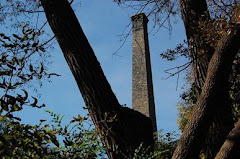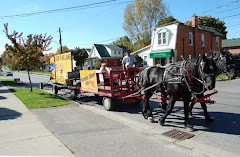Last week on the Guelph Politicast, I told a story of how the Royal City marked it’s 100th, 150th, and 175th anniversaries. For a half-hour podcast, it was a rather exhaustive trip down memory lane, reaching all the way back to Guelph’s founding in 1827 and coming back around to the 21st century. But if you’d rather take a more leisurely stroll through these remembrances, or maybe you just bristle at the sound of my voice, then you can now scroll freely though the text of that podcast.
This history lesson comes courtesy of the Guelph Mercury archives at the University of Guelph library. Unfortunately, how Guelph marked its golden anniversary in 1877 has been lost in time, or at least lost to the U of G library. When it came time for the 50th birthday of Canada as a whole, the Mercury only barely marked the occasion with a list of the country’s accomplishments in the previous five decades. Of course, a lot of that had to do with the First World War. In fact, the Conscription Act had only just been passed two weeks beforehand.
So when Guelph’s centennial came around in 1927, the Royal City was due for a celebration. The Mercury celebrated by publishing a massive 133 page retrospecticus for Guelph’s first 100 years on July 20th, 1927. Why the occasion was marked in July instead of almost three months earlier, I could not discover. Perhaps things were busy that spring, as previously shown on Guelph Politico, widespread spring flooding was very routine in those days.
That July, life in Guelph was certainly routine. The July 14 edition of the Daily Mercury marked the unveiling of the War Memorial in Trafalgar Park at the corner of Woolwich and Woodlawn. Another politician named Guthrie was there for the unveiling, Wellington South MP, and then future Justice Minister, Hugh Guthrie. On the lighter side, June 1927 saw more marriages in a single month-long period than in any other month for the previous four years. That number: 31.
When readers got the centennial edition of the Guelph Mercury on Wednesday July 20, they were greeted with an image of two beavers standing atop twin leaf covered columns. In the centre was a view of Guelph painted in 1830 and published in Edinburgh’s Fraser’s Magazine, likely commissioned to attract newcomers to the then barely three year old City of Guelph. And underneath that was a portrait of the man who founded the Royal City itself, John Galt.
The first story in this exhaustive edition, which must have been the size of most modern weekend papers when received, was about Galt, his life, and his work. This was an “intimate historical sketch of the founder of Guelph as a boy, a man, litterateur, explorer and nation builder - a varied career before wooing fortune on the new continent.”
According to the Mercury, Galt’s father was a merchant sea captain sailing between Clyde and the West Indies. His mother was described by Dr. Moir, a man acquainted with Mrs. Galt, as a “singular woman, shrewd, observant, full of humour, keenly alive to the ridiculous and quaintly original in powers of expression.” Moir would also say, that if “genius and talent are considered as hereditary,” then Galt, “owed these qualities largely to his mother.”
As a child, Galt was considered, again, according to the Mercury, “delicate or rather sensitive.” If he was to be found outdoors it wouldn’t be to play sports or games, but rather partake in gardening. He started with flowers, but soon began to prefer trees and shrubs.
He also liked reading, spending time in his room pouring over ballads and storybooks, evidently nourishing the mind that would eventually itself give birth to several volumes of work in the future covering a wide variety of subjects and genres from pictures of rural life in Scotland to politics and travel. Of course, the fact that he just so happened to bump into Lord Byron while traveling to Gibraltar in 1809, just as the leading romantic writer of the time was heading out on his Grand Tour, was also likely an inspiration.
A writer’s life, for Galt, was imperfect. He didn’t make a living on it, and there were times when business interests had to take precedence over his passion. Now in his mid-40s, Galt knew that he needed financial security for the wellbeing and education for his three sons. It was the mid 1820s and after two wars on two fronts at the same time a decade earlier, Britain was eager to fill the space in their North American colonies. Galt was interested but cautious, he made sure that the money was there to justify the investment, not to the mention the travel, from his home at Eskgrove near Musselburgh. By 1826, the logistics had been sorted out and he set sail for the new world, and history.
Who was John Galt? His friend Dr. Moir described him at the time as “then in his 44th year of Herculean form and in full vigour of health.” He was a tallish man at six-foot-one, his hair was jet black, and he showed little physical sign of a childhood brush with Smallpox.
“In conversation, Mr. Galt’s manner was somewhat measured and solemn yet full of animation and characterized by a peculiar benignity and sweetness,” said Moir. “Except when questioned he was not particularly communicative and in rare company was silent and reserved. His answers however always conveyed the result of a keen discriminative judgment and of an eye that allowed the world to not pass unobserved or unimproved.”
Guelph constituted 40,000 acres bought by the Canada Company, a small portion of the total 1.1 million acres bought by the British government from the Chippewa First Nation in what became known as the Huron tract which would come to include not only Guelph but the towns and villages in Middlesex, Huron and Perth Counties.
But Guelph was Galt’s and from the moment it was born there was controversy. Authorities in London did not like the fact that Galt called his community “Guelph” after the British Royal family, they preferred the name Goodrich for the then-Chancellor of Exchequer, Lord Goodrich. “It seemed absurd that those in charge of the company’s affairs at home should have been so much concerned about the naming of a place which might never amount to anything,” wrote the Mercury 100 years later.
Galt managed to get out of it though by making the case that papers had been sent out already identifying the settlement as “Guelph”. Basically, the ink was already dry on the birth certificate, but Galt did make up for it by being credited as the co-founder of the town of Goodrich on the shores of Lake Huron that same year.
As for Guelph itself, it was in the middle of nowhere. The nearest established settlement in the vicinity was Elora at nearly 20 miles away, but there were no roads to take you there, just miles and miles of forest. Galt recalled the moment he cut down that famous maple on April 23rd 1827 later in his autobiography:
“It was consistent with my plan to invest our ceremony with a little mystery, the better to let it be remembered. So intimating that the main body of the men were not to come we walked to the brow in the neighbouring rising ground and Mr Prior having shown the site selected for the town, a large maple tree was chose on which taking an axe from one of the wood men I struck the first stroke. To me at least the moment was impressive and the silence of the woods that echoed to the sound was the sigh of the solemn genius of the wilderness departing forever.”
Thomas Laidlaw, another Scotsman that came to Guelph and bought a 150-acre farm called the Paisley Block, was also a published poet. He wrote a poem about the first day of Guelph, which is too long to read, but this is how it began.
The sun had set on April DayWas blending with an evening grayThat softly through the forest crept;The stillness of the centuries sleptIn wild retreats and undisturbedThe native haunts of beast and birdA lifted axe! An era’s doomIs knelling thought the forest gloomAnd when at length with crash and swellThe old historic maple fell.
That Prior mentioned before was Charles Prior. Galt met Prior when he arrived in York and hired him be part of the party that headed out into the Huron tract to establish Guelph. Prior became the first city manager, and was the man in charge of Guelph during those early days when Galt was out of town. Prior’s immediate job was to clear the area and supervise the construction of Guelph. He was highly successful at establishing a winter road between Guelph and Goodrich, but he also got into trouble for erecting buildings that were more expensive than necessary, at least in the eyes of the Canada Company who was paying the bills.
In 1866, the Guelph Weekly Mercury, a precursor to the Daily Mercury which would be founded the next year, recorded an early history of Guelph and what came after Galt chopped down that first tree. “Mr Galt’s principal object in forming the settlement was to encourage emigrants to make their future home within its bounds and every means was taken to spread information in regard to the peculiar advantages of the place.”
Over the summer of 1827, many people arrived, mostly men. The men who already had families came early to settle and build a home before bring their wives and children to Guelph. Of particular use in these first month’s of Guelph were men who were good with an axe. “Old and young, the greenhorn and the thoroughly trained chopper, were alike welcome and it made no matter whether or not anything like fair value was given for the wages paid.” With the land clearing, the town started selling lots for the princely sum of $20 each.
The Canada Company’s direct involvement in managing Guelph came to end in 1851 when the Guelph agency was closed, and all books and documents were sent back to the home office. The company’s agent, F.C. Marcon would stay in Guelph and worked at Wellington Mutual Fire Insurance until he died.
But the Canada Company wasn’t done in Guelph. In 1852, they advertised the sale of the lower portion of Market Square, which was around the old City Hall at 59 Carden Street. Citizens called for an open meeting of council to put a stop to the sale, and council, in turn, went to court to defend what it’s people saw as a high-handed attempt of encroachment on the city’s rights. Guelph ended up winning the case using the Canada Company’s own maps and plans that show Market Square as a space specifically reserved for open, public use. This would be the first of many court decisions on land use in the City of Guelph for the next two centuries.
John Galt had already passed on by this time. He had returned back to the old country in Scotland and officially retired in 1834 to the town of Greenock. He died almost 12 years after he founded Guelph on April 11,1939 and is buried in the Old Burying Ground in Greenock alongside his father and his mother. The inscription on the tomb reads “John Galt who died on the 11th April 1839 in his 60th year. Author of the Annals of the Parish.”
In the years to come, the Galts weren’t done making history in Canada. One of John Galt’s sons, Sir Alexander Tilloch Galt, ended up being one of the fathers of Confederation and was Canada’s first Minister of Finance.
All that constitutes maybe five pages of what the Mercury’s special edition covered in 1927. Naturally, those pages were also filled with advertisements.
The International Malleable Iron Company took out a full page advertorial about its large Guelph operation on Beverly Street. Remember the name, it’s going to come up again later in the show. The Ontario Agricultural College also had a full page ad talking about how it’s doors are open to the more than 25,000 young men and women who found opportunity on the other side of those doors.
The City of Guelph’s doors were opened to industry in their own ad, and Robson Motors boasted about a quarter of a million in earnings in its first 15 years of business. It’s worth noting that the “Robson” of Robson Motors was also R.B. Robson, Mayor of the City of Guelph from 1926 to 1931.
But in this special edition of the Mercury, there was plenty of room to recount the paper’s own history. The aforementioned Weekly Mercury ended up merging with the Guelph Advertiser and voila you had the Daily Mercury.
The Advertiser only missed publishing a couple of times, including one incident where the treasurer borrowed the horse that pulled the wheels of the printing press to collect subscriptions in Elora. On the way home, he encountered a horse trader and swapped the horse for a pony, who swiftly dropped dead the first time he was hitched to the press. By the way, the price of that first copy of the Mercury? One cent.
Speaking of Guelph closures, for those mourning the loss of the Guelph Royals, who announced they were folding last month due to poor ticket sales, this special edition of the Mercury noted that baseball in Guelph dated all the way back to 1861, and the formation of the Leafs. The Guelph Leafs, by its 66th year in history, had won several tournaments across Canada and then later in the United States. George Sleeman himself was even a patron of the team.
Another headline hailed that golf is a very popular game in Guelph that that an 18-hole course may be needed in the city before too much longer. And yes, hockey was mentioned too. “Many brilliant hockeyists have played on local teams during the years Guelph has had the Game,” said the Mercury.
Reading through this opus it’s easy to see all the things that informed Guelph as it is today. One page was dedicated to Guelph’s musicians, with special mention going to Noah Sunley, who was Guelph’s first band leader, and Edward Johnson, the famous opera singer and reputedly the World’s Greatest Tenor, who was presented with the Freedom of the City upon returning from a successful tour.
On the front page of the sixth section, the Mercury profiled the Reformatory, which had opened in 1910 and was billed by the Mercury as “the finest correctional institute known.” Of particular note was the programs there to “impress on all inmates the advantages of right living and the rights of individual and society in general to protection against lawlessness.” Apparently, the gardening work done by the inmates brought the attention of hundreds of tourists as they drove by. Of course the York lands today are still a ground for innovation albeit in a different way.
So let’s fast forward 50 years later when Guelph marked its sesquicentennial, and the Mercury kicked things off with a joke on the front of its April 1st edition. “150th missed by one year,” the headline said. “His voice shaking with emotion, Verne McIlwralth chairman of the city’s 150th anniversary committee today revealed Guelph has missed its birthday by one year. A document was uncovered during reconstruction of a local building which reveals John Galt actually cut down the infamous tree in 1826 rather than 1827.” It was an April Fool’s prank, of course. We have not been ignoring revisionist history these last four decades.
The Mercury’s front page news a couple of weeks later was straightforward and self-serving, the installation of a new Urbanite Offset Press, new and extremely sophisticated photo composition equipment called one of the finest available. According to Publisher R.L. Hamill, the new investment cost more that $1.5 million, and came after months of Macgyvering out a paper using “old and new methods” until the new press was installed. Hamill promised that the new Mercury would be easier to read with “crisp and clear photos and eye appealing advertisements.”
“It is most fitting that the great technological change should have been made in Guelph’s 150th anniversary year,” Hamill wrote. “The Mercury has been an integral part of the Royal City and district since the first copy came off an old horse-powered press 27 years after John Galt founded our city. Guelph and the Mercury have come a long progressive way together. Both have a bright future. We hope you will share our enthusiasm and pride on this historic occasion.”
You almost want to go back in time and warn him…
In the days that followed, Guelph businesses started using the occasion to promote their sales. Stewarts Drug Store in St George’s Square offered a number of deals at their Happy Birthday Guelph sale with a pack of 100 Johnson and Johnson bandaids for $1.50, and a 12 ounce bottle of Listerine for $1.17. Meanwhile, a couple of streets over at the BF Goodrich on Cork Street, you could get a 9 inch Mighty Mite sportable TV from RCA for $149.95.
Wayne Campbell, staff writer for the Merc, wrote about what Guelphites could expect at the 150th birthday celebrations in the April 22nd edition: Fireworks, a formal ball, a tree planting, a street party, a hockey tournament, music in front of city hall, and the opening of Heritage Park on Wellington were all on the to-do list. Heritage Park’s opening was of particular significance as the site of the first mill in Guelph near Allen Bridge. Among the ceremonies was a laying of a historical plaque, the laying of a corner stone, and the planting of a sugar maple to replace the one John Galt had cut down to found Guelph 150 years prior.
The next day, Saturday April 23, Guelph Mercury readers were welcomed to Guelph’s birth day with greetings from Premier Bill Davis:
“For a century and a half your fine community has enjoyed a pleasant and peaceful prosperity, situated as you are in the very heart of one of the richest agricultural regions in the world. You have grown, in the past 150 years, from a marketing town to a large and well-rounded urban area interested in agriculture, industry and education on an ever-increasing scale. Your well-known agricultural college has become a highly respected and innovative university. Your growing industrial community has provided more and more work for a young and expanding population. The combination of prosperous farms and a variety of business concerns has given Guelph a positive attitude which has progressed with the years.”
It was probably nice for Bill Davis to partake in a celebration because elsewhere on the front page Rene Levesque was challenging the Ontario premier to a debate on whether Ontario gets more federal money than Quebec. Davis, politely, declined the opportunity.
The editorial page on the Mercury didn’t just echo Davis’ statement but trumped it by talking about Guelph as a city of destiny. April 23, aside from being Guelph’s founding day, was also St. George’s Day. St. George was not just the patron saint of many of the English people that initially came to settle Guelph, but he was also the patron saint of many of the Italian people that started arriving 80 years later.
The editorial briefly went into the mythology of St George and why April 23 is such a significant date in world history. In this “John Galt chose his site, his name and his date well” the editorial said. Of course in 1985, New Coke was launched on April 23, so no date is perfect.
On the day itself, back in 1977, it rained. The spin was that since it rained on the day John Galt cut down that maple tree to create Guelph, it was good fortune and no one was likely in a mood to dispute the claim. “Let us not be dampened by the weather,” said Mayor Norm Jary at the planting of the tree in Heritage Park, “But like the umbrella which opens to be useful, so let us open our minds to news ideas, and our souls to new dreams.”
Wellington MP Frank Maine brought greetings from another Prime Minister Trudeau: “An anniversary of this consequence is a rare opportunity for remembering the triumphs of the past and the people associated with them: Col John Macrae, Edward Johnson, the scholars and teachers of the Ontario Agricultural College, the Ontario Veterinary College and the MacDonald Institute who were precursors of the University which now bears your city’s name,” wrote Pierre Elliot Trudeau. “Guelph’s past is an inspiration for its future. As you look ahead to the challenges which lie before you, as before all Canadians, require even more energy, resourcefulness and creativity.”
Dignitaries in attendance included Ontario’s then Lieutenant Governor Pauline McGibbon, the first woman to hold that title, and, at the time, the newly appointed Chancellor of the University of Guelph, another first for a woman. Mrs F.H. Kortright was also at the celebrations. Aside from having a familiar name if you’re aware of the street in the south end of the city, Mrs. Kortright was also the great grand-daughter of John Galt. Two other of Galt’s great granddaughters were there too: Mrs. RTD Birchall and Mrs Helen Mitchaell Hargraft were all at the anniversary dinner in the U of G’s athletic centre.
“The rain was warm and the ceremony went off beautiful,” said Lt. Governor McGibbon, “Look at all the people who were there and especially the young people. I was completely amazed. When I think of the commitment who arranged it, and the citizens who turned out, they deserve a vote of thanks.”
The only real dark cloud on the day was a stolen time capsule. Vandals dug up a time capsule students at the June Ave Public School had buried the week before, and when the Mercury said the capsule was stolen, then mean just that. The contents of the capsule were found strewn about the ground.
“None of the contents were damaged but a lot of work went into preparing the capsule and that has been lost,” said principal J.D. Simpson. “I think whoever did this made a mistake. They probably think they’ve got a good tackle box now or something.” The time capsule was an 18-inch long blue tool box painted silver.
Looking to Guelph’s 175th year in April 2002, the Mercury was reporting that city officials were looking to undo some of the mistakes of the past. In the weekend paper on April 6 there was an article about a draft document from the city’s first director of policy planning on how Guelph could deal with contaminated sites and brownfields within the city, including the old IMICo site on Beverly Street that still lies vacant and contaminated to this day, if maybe not for much longer.
In the week leading up to the Royal City’s Dodransbicentennial, another perfectly Guelph moment was occurring with the beginning of Ontario Municipal Board hearings into the construction of the Walmart Smart Centre at the corner of Woodlawn and Woolwich. April 16 was the first day of a 20-week hearing that would dispatch the question of not just Walmart’s development in the north end, but the proposed Zellers store to be built on Stone Road in the south end on land owned by the University of Guelph. That store, you may recall, became a Walmart last year.
As the anniversary date drew closer, the Mercury offered a full page coloured flag for citizens to put in the window of their homes, classrooms and businesses. The citizens flag has two horizontal stripes, one red and one white with a white horse head on top over the red stripe and a red crown over the white stripe underneath.
On April 20th, Joanne Shuttleworth printed a list of events for the 175th including the annual Founders Day celebration held by the Guelph Historical Society, the 175th Birthday Scholarship Fundraising Dinner at the River Run Centre, the Freedom of the City Parade, and a special Doors Open Guelph.
Speaking of history, a new permanent exhibit was revealed at the Guelph Civic Museum. The new John Galt History Hall would be opened on Tuesday April 23rd thanks to a generous donation by Linamar, and would feature a number of interactive exhibits and displays, including artefacts that span the years from Guelph’s founding in 1827 to the then present day of 2002. There would also be articles from before Guelph’s founding. Relics from the Anishnabe Ojibwa Indigenous peoples that called the Guelph area home after defeating the Iroquois here in the 1700s.
Perhaps most poignantly, in the midst of the celebration, was when Mercury writer Eric Volmers reminded everyone that Galt, the legendary figure that started this story, thought himself as a failure.
Two years after chopping down that tree, Galt was forced to do odd jobs to make ends meet, and take writing assignments that might have paid the bills, but unlikely fed a writer’s soul. Even then, he did a little time in debtors prison, and he was recalled to England by the Canada Company out of concern that he wasn’t doing a good job as either a bookkeeper or a manager.
He died concerned that history would only remember him as a failure, if it remembered him at all. 190 years later though his bust sits in the middle of town, he has a day of celebrations named after him, and the decedents of the townspeople he brought here are gradually rediscovering his literary works. I think his legacy turned out okay.
So now Guelph is 190 years old. It’s still growing and it’s still going strong, and already we’re looking towards our bicentennial. An item on the agenda for the July Committee of the Whole meeting is to begin the planning of special events related to the Royal City’s 200th birthday in 2027.
How will our city change in the next decade? What will it look like when our 200th year roles around? Stay tuned.




























No comments:
Post a Comment